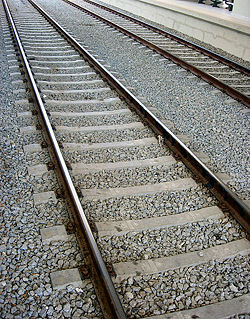Parallel (geometry): Difference between revisions
imported>Paul Wormer No edit summary |
imported>Boris Tsirelson (removing infinity) |
||
| Line 1: | Line 1: | ||
{{subpages}} | {{subpages}} | ||
[[Image:Rail tracks @ Coina train station 04.jpg|thumb|250px|alt=Picture of railroad tracks.|Railroad tracks must be parallel to each other or else trains will derail.]] | [[Image:Rail tracks @ Coina train station 04.jpg|thumb|250px|alt=Picture of railroad tracks.|Railroad tracks must be parallel to each other or else trains will derail.]] | ||
In [[Euclidean geometry]] two '''parallel''' (symbolized by two adjacent vertical lines '''∥''') lines in a [[Plane (geometry)|plane]] do not cross. Two geometric entities (lines or planes) are said to be '''parallel''' if they do not [[intersect_(geometry)|intersect]] anywhere, that is, if they do not have a single point in common. Thus, two [[line_(geometry)|lines]] are parallel if they belong to the same plane and do not cross at any [[point_(geometry)|point]], | In [[Euclidean geometry]] two '''parallel''' (symbolized by two adjacent vertical lines '''∥''') lines in a [[Plane (geometry)|plane]] do not cross. Two geometric entities (lines or planes) are said to be '''parallel''' if they do not [[intersect_(geometry)|intersect]] anywhere, that is, if they do not have a single point in common. Thus, two [[line_(geometry)|lines]] are parallel if they belong to the same plane and do not cross at any [[point_(geometry)|point]], no matter how far. | ||
More than one line may be parallel to any number of other lines, which all are parallel to one another. In other word, parallel lines satisfy a transitivity relation. Writing ''PQ'' for a line connecting two different points ''P'' and ''Q'', this means | More than one line may be parallel to any number of other lines, which all are parallel to one another. In other word, parallel lines satisfy a transitivity relation. Writing ''PQ'' for a line connecting two different points ''P'' and ''Q'', this means | ||
:<math> | :<math> | ||
Revision as of 06:55, 28 March 2010
In Euclidean geometry two parallel (symbolized by two adjacent vertical lines ∥) lines in a plane do not cross. Two geometric entities (lines or planes) are said to be parallel if they do not intersect anywhere, that is, if they do not have a single point in common. Thus, two lines are parallel if they belong to the same plane and do not cross at any point, no matter how far. More than one line may be parallel to any number of other lines, which all are parallel to one another. In other word, parallel lines satisfy a transitivity relation. Writing PQ for a line connecting two different points P and Q, this means
Similarly two planes in a three-dimensional Euclidean space are said to be parallel if they do not intersect in any point. It can be proved that if they intersect in a point that they intersect in a line. Writing PQR for a plane passing through three different point P, Q, and R, parallellity of planes is a transitivity relation that may be written as follows


